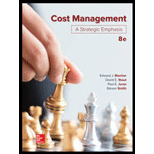
Concept explainers
Provide appropriate answer for (a) to (e).
Explanation of Solution
Provide appropriate answer for (a) to (e) as follows:
(a) Calculate the payback period for project A.
(b) Calculate the payback period for project B.
| Year | After tax cash inflows | Cumulative after tax cash inflows |
| 1 | $ 500 | $ 500 |
| 2 | $ 1,200 | $ 1,700 |
| 3 | $ 2,000 | $ 3,700 |
| 4 | $ 2,500 |
Table(1)
(c) Calculate the payback period for project C.
Working note (1):
Calculate the
Working note (2):
Calculate the taxable income each year.
Working note (3):
Calculate the annual after-tax net
(d) (1) Calculate the accounting rate of return based on the original investment of project D.
Working note (4):
Calculate the depreciation expense for project D.
Working note (5):
Calculate the operating income after tax for project D.
| Particulars | Amount ($) | Amount ($) |
| Sales | $ 4,000 | |
| Less: Expenses | ||
| Cash expenditures | $ 1,500 | |
| Depreciation (4) | $ 900 | $ 2,400 |
| Operating income before tax | $ 1,600 | |
| Less: Income tax @25% | $ 400 | |
| Operating income after tax | $ 1,200 |
Table (2)
(d) (2) Calculate the accounting rate of return based on the average investment of project D.
Working note (6):
Calculate the average book value.
e. Calculate the net present value for project A, project B, project C and project D.
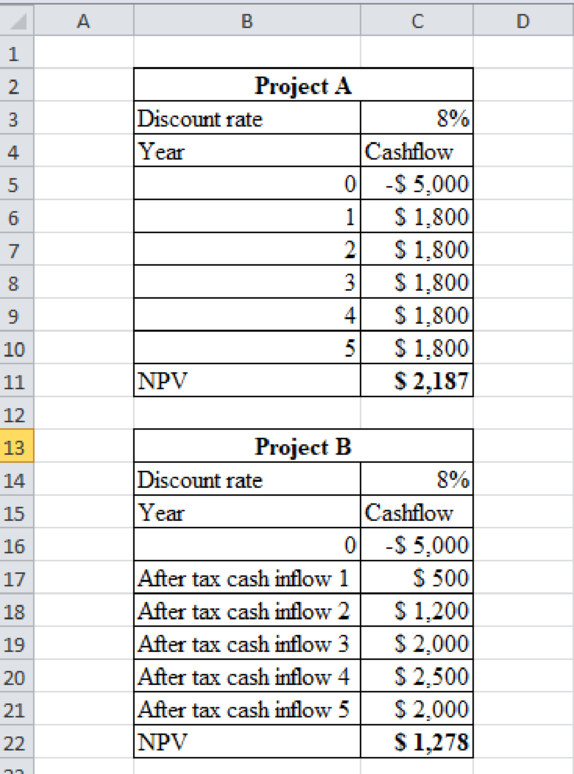
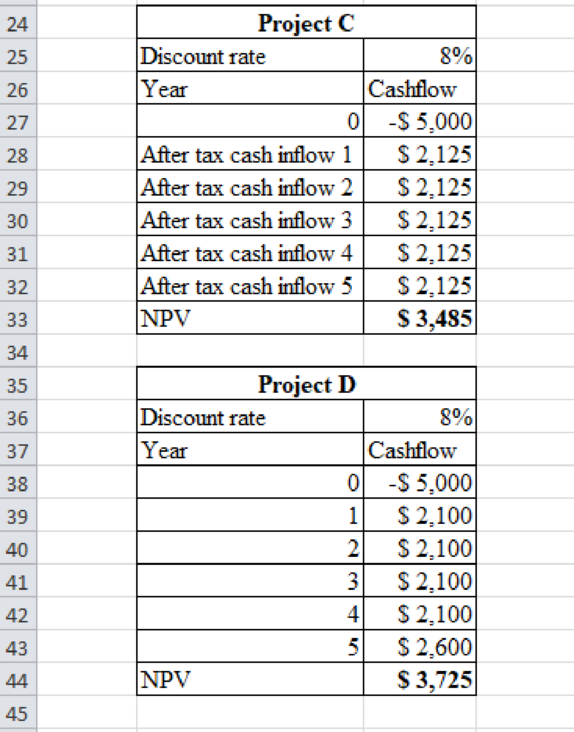
Table (3)
Workings:
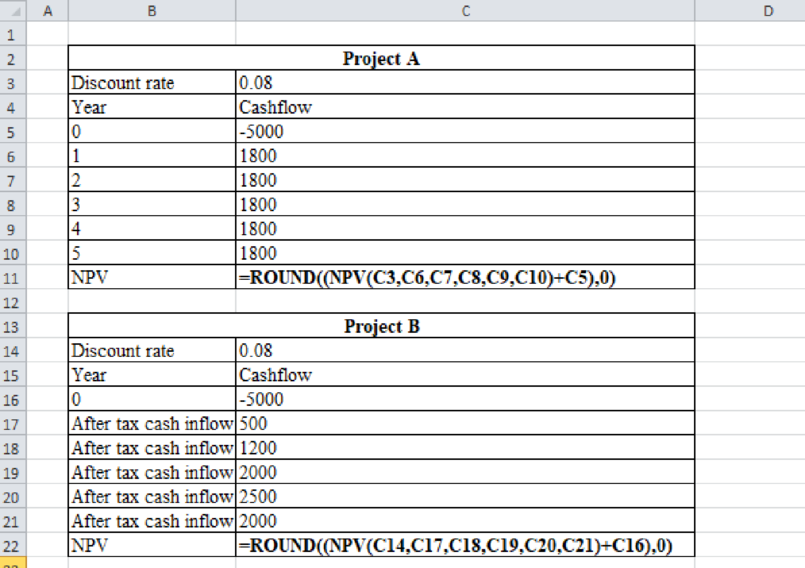
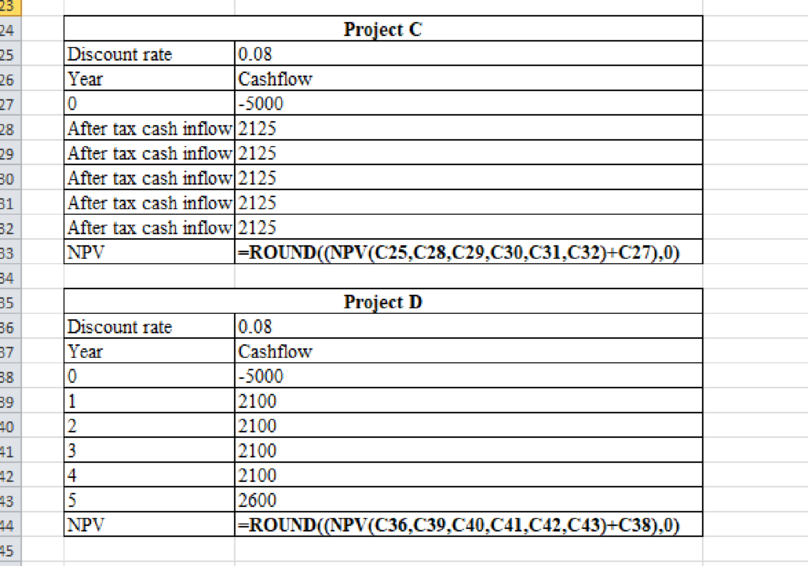
Table (4)
Want to see more full solutions like this?
Chapter 12 Solutions
Cost Management
- Please provide the correct answer to this general accounting problem using accurate calculations.arrow_forwardLarkson Equipment purchased a conveyor system for $52,000 on January 1, 2019. The system has an expected salvage value of $3,000 and is expected to be used for 200,000 hours over its estimated useful life of 8 years. Actual usage was 22,000 hours in 2019 and 18,500 hours in 2020. Calculate depreciation expense per hour under the units-of-activity method. (Round the answer to 2 decimal places).arrow_forwardLabor rate variance is?arrow_forward
- Franklin Corp. has 25 million shares outstanding and trades at $38 per share. Franklin has net identifiable assets with a book value of $800 million and a fair value of $950 million. Riverdale Investments purchases all of Franklin Corp.'s stock for $48 per share. How much will Riverdale Investments record as goodwill upon acquiring Franklin Corp.?arrow_forwardI need assistance with this financial accounting question using appropriate principles.arrow_forwardI am looking for the correct answer to this general accounting problem using valid accounting standards.arrow_forward

 AccountingAccountingISBN:9781337272094Author:WARREN, Carl S., Reeve, James M., Duchac, Jonathan E.Publisher:Cengage Learning,
AccountingAccountingISBN:9781337272094Author:WARREN, Carl S., Reeve, James M., Duchac, Jonathan E.Publisher:Cengage Learning, Accounting Information SystemsAccountingISBN:9781337619202Author:Hall, James A.Publisher:Cengage Learning,
Accounting Information SystemsAccountingISBN:9781337619202Author:Hall, James A.Publisher:Cengage Learning, Horngren's Cost Accounting: A Managerial Emphasis...AccountingISBN:9780134475585Author:Srikant M. Datar, Madhav V. RajanPublisher:PEARSON
Horngren's Cost Accounting: A Managerial Emphasis...AccountingISBN:9780134475585Author:Srikant M. Datar, Madhav V. RajanPublisher:PEARSON Intermediate AccountingAccountingISBN:9781259722660Author:J. David Spiceland, Mark W. Nelson, Wayne M ThomasPublisher:McGraw-Hill Education
Intermediate AccountingAccountingISBN:9781259722660Author:J. David Spiceland, Mark W. Nelson, Wayne M ThomasPublisher:McGraw-Hill Education Financial and Managerial AccountingAccountingISBN:9781259726705Author:John J Wild, Ken W. Shaw, Barbara Chiappetta Fundamental Accounting PrinciplesPublisher:McGraw-Hill Education
Financial and Managerial AccountingAccountingISBN:9781259726705Author:John J Wild, Ken W. Shaw, Barbara Chiappetta Fundamental Accounting PrinciplesPublisher:McGraw-Hill Education





